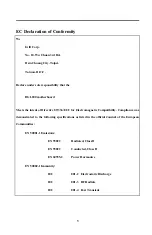
1-8
Chapter 1: Product introduction
•
The default memory operation frequency is dependent on its Serial Presence Detect
(SPD), which is the standard way of accessing information from a memory module.
Under the default state, some memory modules for overclocking may operate at a
lower frequency than the vendor-marked value. To operate at the vendor-marked
or at a higher frequency, refer to section
2.5 Ai Tweaker menu
for manual memory
frequency adjustment.
• Always install the DIMMS with the same CAS Latency. For an optimum compatibility,
we recommend that you install memory modules of the same version or data code
(D/C) from the same vendor. Check with the vendor to get the correct memory
modules.
•
For system stability, use a more efficient memory cooling system to support a full
memory load (4 DIMMs) or overclocking condition.
•
You may install varying memory sizes in Channel A and Channel B. The system maps
the total size of the lower-sized channel for the dual-channel configuration. Any excess
memory from the higher-sized channel is then mapped for single-channel operation.
•
According to Intel
®
CPU spec, DIMM voltage below 1.65V is recommended to protect
the CPU.
•
Due to the memory address limitation on 32-bit Windows
®
OS, when you install 4GB
or more memory on the motherboard, the actual usable memory for the OS can be
about 3GB or less. For effective use of memory, we recommend that you do any of the
following:
-
Use a maximum of 3 GB system memory if you are using a 32-bit Windows
®
OS.
-
Install a 64-bit Windows
®
OS if you want to install 4GB or more on the
motherboard.
-
For more details, refer to the Microsoft
®
support site at
http://support.microsoft.
com/kb/929605/en-us
.
Visit the ASUS website at www.asus.com for the latest QVL.
1.4.3
Installing a DIMM
1
Содержание H170 PRO GAMING
Страница 1: ...Motherboard H170 PRO GAMING ...
Страница 10: ...x ...















































